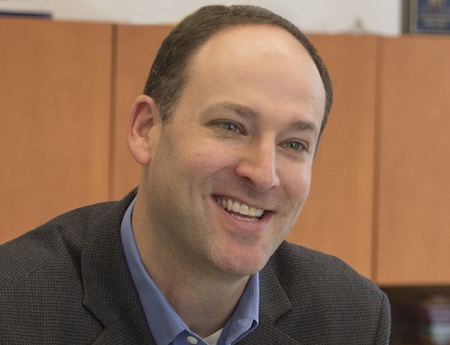Scripps Scripts Multilayered Digital Story

With media roots dating back to the penny-press days, E.W. Scripps is future-focused when it comes to digital.
In the third quarter, Scripps’ digital revenue increased 45% over last year’s Q3 to $15.8 million. While digital represented just 7% of overall quarterly sales of $233 million and losses have been booked in recent quarters due to the cost of acquisitions and integrations, the segment is growing. Along with continued expansion by the station group into social media and digital platforms as a way of supplementing linear broadcasts, the company’s strides earned Scripps this year’s honor as B&C’s Multiplatform Broadcaster of the Year.
Key recent acquisitions include top podcast player Midroll (primarily an ad network but also operator of the popular Stitcher app, which Scripps bought last June) and satire brand Cracked (a onetime competitor to Mad) last spring. Along with Newsy, a millennial OTT video service brought aboard in 2013, they give Scripps several weapons in the fight to retain audiences beyond the traditional bundle or over-the-air ecosystem.
“This year is when what used to be a wide gap between internet and TV began to seriously narrow,” says CEO Rich Boehne.
Scripps’ digital strategy is “consistent with our long history spanning newspapers, radio, local television and cable,” said COO Adam Symson. “When you look at us, you see a company with a long history and a culture and a strategy that’s always about creating business in a media landscape where we see the consumer going.”
For any legacy company, especially one with still-vibrant traditional holdings, the main challenge is how to integrate new technology into existing operations. Sometimes an external event shines a bright light on that challenge. In 2016, it was the presidential election cycle.
“There’s no question that the broadcast TV platform will continue to be the best way to connect politicians with voters,” Symson said. “While that remains true, we’re experiencing a moment where journalism itself is experiencing a ‘niche-ing.’ We have moved to create value.” While stations’ political ad revenue of roughly $100 million for the year fell significantly short of expectations, Cracked, whose OTT satire Boehne describes as “no different from The Daily Show,” made hay of the singular campaign.
Broadcasting & Cable Newsletter
The smarter way to stay on top of broadcasting and cable industry. Sign up below
“We saw record traffic in the days before and after at Cracked because the content we were producing was hyper-relevant,” Symson said. Will Scripps increasingly try to reach viewers through services like Cracked, which is available through new-model distributors like Roku, Pluto TV and connected TV platform Xumo, instead of via broadcast stations? “The answer at Scripps is always both,” Symson said.
The rank-and-file see their company showing more willingness to compete against itself, in some respects. Newsy, known for punchy news segments aimed at cord-cutting millennials, just closed a deal to make content available to Hulu’s 12 million subscribers, many of whom are viewers of their local Scripps stations.
Symson describes the company’s culture as “very progressive.” Even so, he adds, “There’s a lot of energy about the changes we are working through about the channels. There is a reasonably high level of discomfort as a result of that progress.”
The COO adds: “The industry is too comfortable. When you’re too comfortable, it’s too easy not to push for change. When you don’t push in a direction toward comfort, it’s too easy to find discomfort.…It’s not an easy thing for our own employees. There is an instinct sometimes to crave only comfort. In an industry today that is being challenged by fragmentation and unfettered choice, to accept comfort as the goal is a mistake.”
Newsy’s addition of Hulu follows carriage deals on Roku, Apple TV and other majors. The site has already surpassed 1 billion video views, Symson said, with demand from advertisers (and rates) “very consistent.” Plus, the average session for Roku viewers of Newsy was 26 minutes in the third quarter, comparable with levels on other on-demand platforms.
The service has also secured web distribution via Raycom station sites and a linear deal with Cincinnati Bell. In linear, average viewing in October (the most recent month with available data) rises to 70 minutes, the company said.
Despite overall convergence, Symson said selling advertising remains a distinct process in each sphere, with little overlap. “Thus far, we haven’t really seen that the target is the same,” he said. “But over the next several years, as we see the buying process change and the workflows change, we certainly think there’s going to be opportunity.”
And on the subject of opportunity, Scripps is a big believer in podcasting, a form that was catapulted into the public consciousness in 2015 thanks to shows like Serial. “You will see a lot more from us in the space,” predicts Symson. “It is a way to diversify our audiences and our platforms.” The first beachhead is Midroll, a six-year-old company based in L.A. that produces podcasts and handles advertising for 200-plus top shows, among them WTF WithMarc Maron, The Nerdist and StartUp.
The format is “a piece of the market that has been somewhat overlooked because it has been seen as less sexy as video,” Boehne said. “But we feel it gives us a lot of room to run.” Connected cars are an important and growing base for podcasts. While total segment revenue is still a fledgling $34 million, Nielsen coverage (confirmed earlier this year) and enhanced metrics from key tech stakeholders are seen as possible stimulants.
To Symson, speaking with B&C in November as the company—and the nation—sought to process the implications of the election’s outcome, Scripps’ digital maneuvers share one common bit of upside: ways to re-examine the generations-old connection with viewers.
“Our local and digital brands need to be working together,” he said. “There’s a moment right now where we have to evaluate how we are serving the local audience.”










